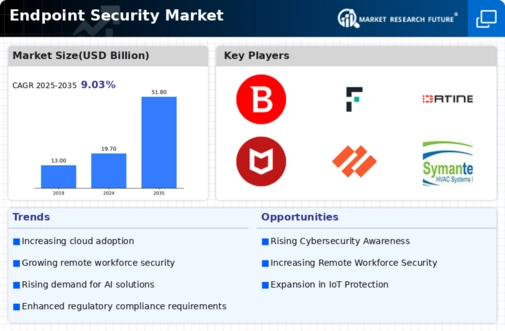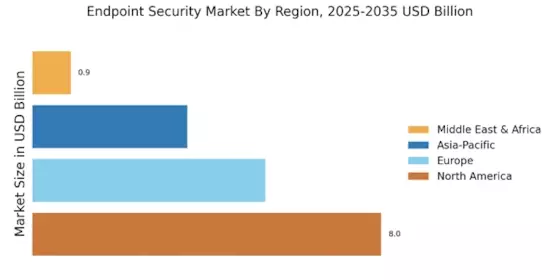The Endpoint Security Market is currently characterized by a dynamic competitive landscape, driven by the increasing sophistication of cyber threats and the growing demand for robust security solutions across various sectors. Major players such as CrowdStrike (US), Palo Alto Networks (US), and Trend Micro (JP) are strategically positioning themselves through innovation and partnerships to enhance their market presence. CrowdStrike (US) focuses on cloud-native solutions, leveraging artificial intelligence to provide real-time threat detection, while Palo Alto Networks (US) emphasizes its comprehensive security platform that integrates advanced analytics and automation. Trend Micro (JP) is also notable for its commitment to research and development, which underpins its proactive approach to emerging threats, thereby shaping a competitive environment that prioritizes technological advancement and customer-centric solutions.
The business tactics employed by these companies reflect a concerted effort to optimize operations and enhance service delivery. For instance, localizing manufacturing and optimizing supply chains are becoming increasingly important as companies seek to reduce costs and improve responsiveness to market demands. The Endpoint Security Market appears moderately fragmented, with a mix of established players and emerging startups, each contributing to a competitive structure that fosters innovation and agility. The collective influence of these key players is significant, as they not only set industry standards but also drive the evolution of security protocols and practices.
In August 2025, CrowdStrike (US) announced a strategic partnership with a leading cloud service provider to enhance its threat intelligence capabilities. This collaboration is expected to bolster CrowdStrike's offerings by integrating advanced machine learning algorithms, thereby improving the accuracy of threat detection and response. Such strategic moves are indicative of the company's commitment to staying ahead of the curve in a rapidly evolving threat landscape.
In September 2025, Palo Alto Networks (US) launched a new suite of AI-driven security tools aimed at small and medium-sized enterprises (SMEs). This initiative not only expands its customer base but also addresses the growing need for accessible security solutions among smaller organizations. The strategic importance of this launch lies in its potential to democratize advanced security technologies, making them available to a broader audience and enhancing overall market penetration.
In July 2025, Trend Micro (JP) unveiled a new cybersecurity framework designed specifically for the healthcare sector, which has been increasingly targeted by cybercriminals. This framework integrates advanced threat detection with compliance management, reflecting Trend Micro's strategic focus on vertical-specific solutions. The introduction of such tailored offerings underscores the importance of industry-specific strategies in addressing unique security challenges.
As of October 2025, the Endpoint Security Market is witnessing trends that emphasize digitalization, sustainability, and the integration of artificial intelligence. Strategic alliances are becoming increasingly pivotal, as companies recognize the value of collaborative innovation in enhancing their competitive edge. Looking ahead, it is likely that competitive differentiation will evolve, shifting from traditional price-based competition to a focus on innovation, technological advancement, and supply chain reliability. This transition suggests that companies that prioritize these elements will be better positioned to thrive in an increasingly complex and competitive landscape.


















Leave a Comment